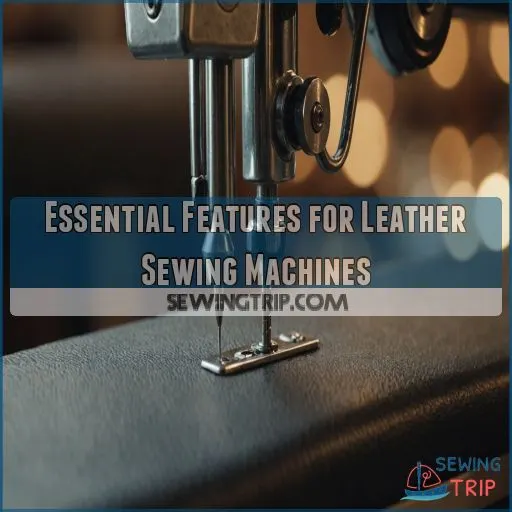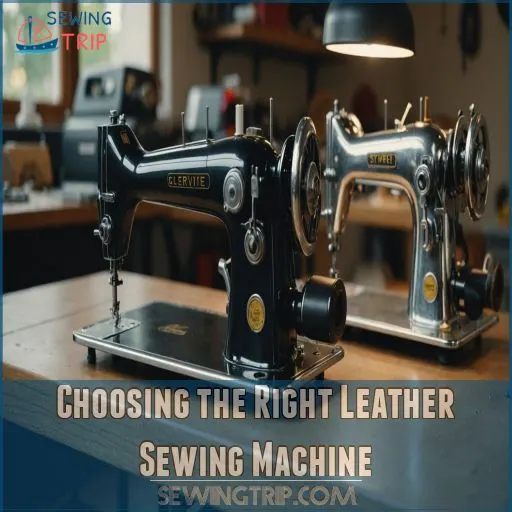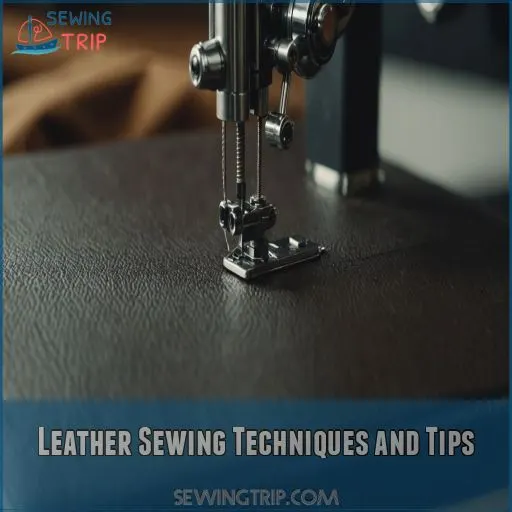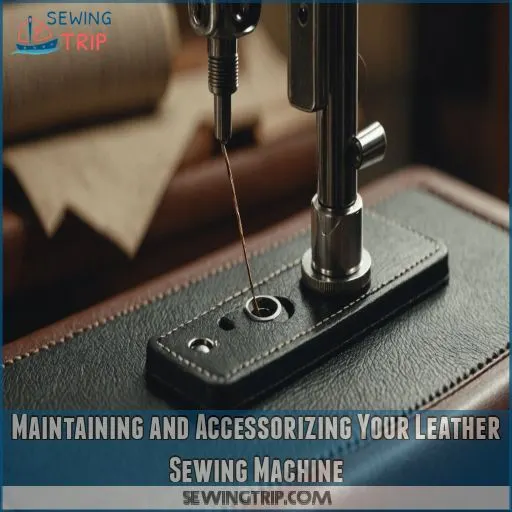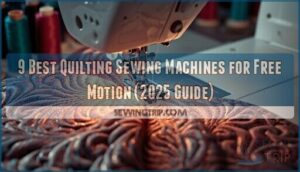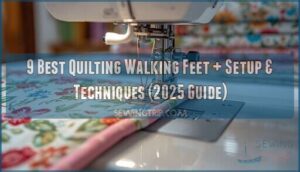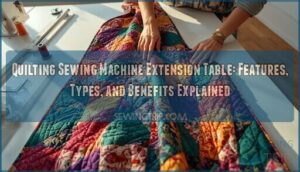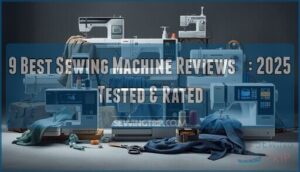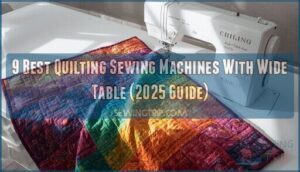This site is supported by our readers. We may earn a commission, at no cost to you, if you purchase through links.
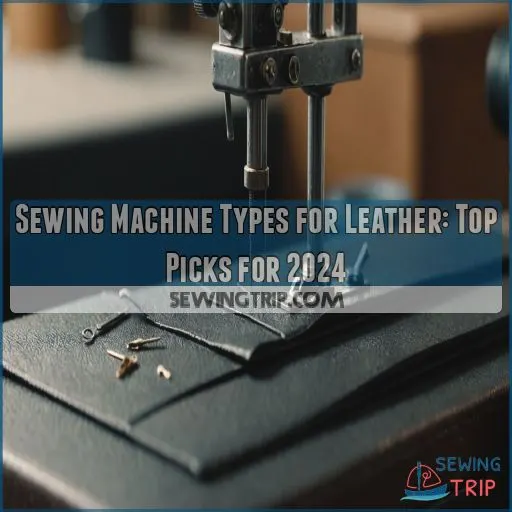
There are several sewing machine types for leather: cylinder arm machines work wonders for tricky 3D structures like bags; flatbeds give you space for larger projects; post beds handle curves like a pro—ideal for shoes; while combination machines offer a blend of features for versatility.
Industrial machines pack a punch for those heavy-duty tasks.
Remember, picking the right machine is like choosing the perfect partner—they’ve gotta handle your material’s thickness and quirks. Curious about the must-have features? Stick around!
Table Of Contents
Key Takeaways
- When you’re wrestling with thick leather projects, cylinder arm machines are like your best buddies, making tricky 3D shapes a breeze. Think of them as the ninja warriors of the sewing world—agile and precise!
- Got your sights set on big projects like upholstery? Flatbed machines offer plenty of elbow room and keep your fabric gliding smoothly. They’re like that reliable friend who always brings extra snacks to the party.
- If you’re shaping curves or stitching up shoes, post bed machines have got your back. They’re like the yoga instructors of sewing, mastering the art of graceful bends and turns with ease.
- For those who want it all, combination machines blend the best features of flatbeds and cylinder arms. They’re like your sewing Swiss Army knives, ready to tackle any leather task you throw at them!
Sewing Machine Types for Leather
Choosing the right sewing machine for leather can be as tricky as choosing the perfect leather jacket—both are investments that need to fit your needs just right.
Whether you’re stitching up a chic handbag or tackling a heavy-duty leather project, knowing the different types of sewing machines can save you a lot of time and leather scraps.
Cylinder Arm Machines for 3D Structures
Cylinder arm machines are your best buddies for crafting complex 3D structures like bags, belts, or delicate saddle stitching.
Their unique design lets you easily maneuver thick leather through its round, compact workspace.
With these machines, you’ll find yourself conquering 3D stitching techniques, making them indispensable for leather enthusiasts aiming for intricate, high-quality projects.
Ready to roll those sleeves up?
Flatbed Machines for Large Projects
If you’re tackling large leather projects like upholstery or bags, a flatbed sewing machine is your new best friend.
With its expansive work surface, you can easily maneuver and position bulky materials.
Plus, the feed dogs on a flatbed machine will keep your leather moving smoothly under the presser foot for consistent stitching.
Post Bed Machines for Shaping 3D Structures
When you’re stitching something like shoes or 3D leather structures, a post bed machine is your trusty sidekick.
Picture stitching around curves and contours—it’s got your back!
Brands specialize in offering a perfect marriage of walking foot and feed dogs.
So, add a post bed to your arsenal and watch your leatherworking dreams take flight.
Combination Machines for Versatility
Ready to handle a hat trick of leather projects? Combination machines are your best bet! They blend the strengths of flatbed and cylinder arms, offering you versatility—think of them as the Swiss knives of sewing.
Whether it’s bags or belts, these machines adapt easily.
Plus, with walking feet and a range of feed mechanisms, you’re covered no matter the leather thickness.
Industrial Sewing Machines for High-Volume Production
Now, let’s talk about industrial sewing machines for high-volume production. These bad boys tackle leather projects like a walk in the park. They’re built for the long haul.
- Power-packed Performance: Designed for heavy-duty.
- Production Efficiency: Reduces downtime.
- Cost-Effectiveness: Lower maintenance costs.
- Ease of Maintenance Scheduling: Routine checks guarantee longevity.
- Operator Training: Simple enough for the team.
Essential Features for Leather Sewing Machines
When sewing leather, the right machine features can make all the difference.
From maximum sewing thickness to specialized feed mechanisms, understanding the essential elements will help your projects turn out flawless.
Maximum Sewing Thickness for Handling Various Leather Types
You’ve explored sewing machine types, but let’s square up with your project needs. Leather thickness can stump even seasoned stitchers, so picking a machine with the right maximum sewing thickness is a game-changer.
| Leather Type | Needle Size | Max Sewing Thickness |
|---|---|---|
| Light | 90/14 | 1/8 inch |
| Medium | 100/16 | 1/4 inch |
| Heavy | 110/18 | 1/2 inch |
| Extra Heavy | 120/19 | 3/4 inch |
| Industrial | 130/21 | 1 inch |
More power means smoother stitches, like slicing butter with a hot knife.
Thread and Needle Sizes for Optimal Stitching Performance
When stitching leather, thread size and needle gauge are like Batman and Robin—inseparable heroes!
Choose a leather needle designed to pierce tough material without causing needle damage.
Match this with a thicker thread, like waxed thread, for strong, neat stitching.
Make sure the stitch length suits your leather type to avoid a sewing fiasco!
Motor Specifications for Power and Efficiency
Striking the right balance, after thread and needle sizes, it’s time to get motor savvy.
You’ll juggle factors like motor size, RPM, torque, and power consumption to make sure your heavy-duty sewing machine doesn’t hog electricity like the Juki DDL-5550.
A robust motor delivers:
- Consistent, powerful stitching.
- Effortless handling of tough leather thickness.
- Enhanced control over the feed mechanism.
- Extended duty cycle for longer projects.
Special Features and Attachments for Enhanced Sewing Experience
Don’t forget to look for special features that’ll make your leather sewing a breeze.
A bobbin winder, reverse stitching, and adjustable stitch length are game-changers.
And those presser feet – Teflon, walking, even a free-motion foot – can be lifesavers for tricky leather projects.
Dial in the tension just right, and you’ll be stitching like a pro.
Selecting the Right Feed Mechanism for Smooth Fabric Feed
You’ve got the machine ready—let’s talk feed types.
A walking foot or needle feed helps smooth fabric flow, so consider these heroes when sewing leather.
Compound feed handles varying thicknesses like a charm, while drop feed suits straightforward tasks.
Adjust stitch length for thick materials, making sure each pass of the sewing machine foot is a win with the Singer 241-12’s heavy-duty capabilities. https://sewingtrip.com/singer-commercial-sewing-machine-model-241-12/. Happy sewing!
Top 3 Leather Sewing Machines
If you’re looking to tackle all sorts of leather projects, you’ll need the right sewing machine to get the job done.
Check out our top picks for 2024: the Singer Heavy Duty, Singer 9960 Sewing Quilting Machine, and Brother ST371HD—machines as tough as leather and ready for your next masterpiece!
1. Singer Heavy Duty Sewing Machine
Looking to tackle leather projects with ease? The Singer Heavy Duty Sewing Machine is your trusted sidekick. It’s like the Swiss Army knife of sewing machines, equipped with 23 built-in stitches and a powerful motor, sewing up to 1,100 stitches per minute.
Perfect for projects like quilts, crafts, or fashion pieces.
While it does have some plastic parts, its durable metal frame makes it sturdy. Just keep an eye out for bobbin tension issues. It’s ideal for sewers seeking a reliable machine without breaking the bank!
Best For: The Singer Heavy Duty Sewing Machine is best for beginners and experienced sewers alike who need a reliable machine for a variety of projects, including leather work.
- Powerful motor for sewing through thick fabrics.
- Durable metal frame for stability and longevity.
- Comes with a variety of accessories for different sewing needs.
- Some users have reported issues with bobbin tension and tangling.
- The machine has a lot of plastic parts, including the bobbin, bobbin case, and sewing foot guides.
- There have been reports of the bobbin stopping spinning after a short period of use.
2. Singer 9960 Sewing Quilting Machine
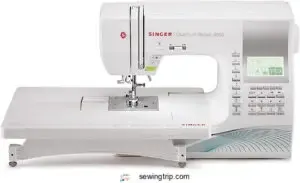
The Singer 9960 Quantum Stylist is a versatile machine that’s perfect for leather projects.
With 600 built-in stitches, an extension table, and a smooth fabric feed, it handles everything from clothes-making to heavy-duty leather work.
The automatic needle threader is a lifesaver, and the 850 stitches-per-minute speed means you’ll fly through your projects in no time.
Whether you’re crafting leather bags, belts, or upholstery, the 9960 has the power and precision to tackle it all.
It’s a real workhorse that’ll make your leather sewing a breeze.
Best For: The Singer 9960 Quantum Stylist is best for sewers of all levels who want a versatile machine for a variety of projects, including leatherwork.
- The Singer 9960 Quantum Stylist has a wide range of built-in stitches, making it perfect for a variety of projects.
- The automatic needle threader is a great feature for making sewing easier and faster.
- The extension table provides extra space for larger projects.
- The Singer 9960 Quantum Stylist is a bit pricey compared to other sewing machines, even some of the Sailrite models https://sewingtrip.com/best-sailrite-sewing-machine/.
- The instruction manual is not available in Portuguese.
- Some users recommend purchasing a separate 1/4" seam foot.
3. Brother ST371HD Sewing Machine

Meet the Brother ST371HD Sewing Machine, your trusty sidekick for tackling leather projects with flair.
It’s like having a superhero in your sewing room, handling everything from lightweight cotton to sturdy upholstery.
With 37 built-in stitches, sewing will be like a walk in the park.
While some users grumble about the presser foot lifter’s flimsiness, its quiet operation and portability more than make up for it.
Perfect for those who need a reliable machine to navigate the leather jungle effortlessly!
Best For: The Brother ST371HD Sewing Machine is best for beginners and hobbyists who want a versatile machine for a range of fabrics, including leather.
- Easy to thread and wind bobbins.
- Handles a wide range of fabrics, from lightweight cottons to upholstery materials.
- Quiet operation and lightweight for portability.
- The presser foot lifter has been reported to be flimsy by some users.
- The needle threader may not always work properly.
- Not suitable for use in Europe due to voltage differences.
Choosing the Right Leather Sewing Machine
Choosing the right leather sewing machine can feel like picking the perfect pizza topping, but it doesn’t have to be a slice of chaos like browsing our top picks.
Focus on your leather’s thickness, a motor that’s more horsepower than house cat, and match the machine to your project’s needs—your future self will thank you!
Assessing Leather Type and Thickness for Machine Selection
Now that we’ve covered some top sewing machine brands, let’s chat about matching them to your leather type and thickness.
Ever tried cutting butter with a plastic knife? Same deal here. Heavier leather requires a machine with a solid needle gauge and adjustable stitch length.
Tackle project complexity by checking sewing machine reviews to make sure it handles your leather density smoothly.
Evaluating Motor Power and Special Features for Optimal Performance
When choosing a leather sewing machine, don’t overlook the motor power and special features.
A robust motor makes sure your machine can handle thick, heavy-duty leathers without bogging down.
Look for adjustable stitch length, speed control, and durable construction – these extras will elevate your sewing experience and stitch quality.
Power up your leather projects!
Comparing Machines for Specific Applications
Choosing the right leather sewing machine is like finding the perfect pair of shoes; it’s got to fit your project’s needs—whether it’s bags, belts, or shoes.
For heavy-duty leather, throw in a sturdy machine, preferably with sewing machine accessories.
For garments, a lighter touch might be your style.
Check out sewing machine parts; a well-oiled machine never disappoints!
Leather Sewing Techniques and Tips
Finding the right leather sewing machine is like picking the perfect partner—you need to know how to stitch your projects together seamlessly, and a good industrial sewing machine can be your best friend.
Once you’ve narrowed down your choice, focus on mastering leather sewing techniques and tips.
- Use Leather Needles: These bad boys pierce tough fibers without crumpling under pressure. Don’t forget, dull needles will skip stitches like a broken record!
- Adjust Stitch Length: Aim for around 2mm; it’ll penetrate thick leather without the Swiss cheese effect.
- Mind Your Tension: Adjusting it is like finding zen with your machine. Dial it in for smooth sailing.
- Hand Stitching Magic: For those tricky spots, channel your inner artisan with some good ol’ hand stitching. It’ll keep your project as tight as a drum!
Maintaining and Accessorizing Your Leather Sewing Machine
Taking care of your leather sewing machine is like giving your trusty car regular oil changes—it keeps everything running smoothly and prevents breakdowns.
Specialty feet for tricky fabrics and waxed thread for that extra strong stitch that’ll outlast your last diet will help you accessorize your machine.
Regular Maintenance for Machine Performance and Longevity
Regularly dusting the bobbin case, oiling moving parts, and avoiding water-based cleaners will keep your leather sewing machine humming along.
Treat your trusty steed right, and it’ll reward you with smooth, even stitches for years to come.
Needle care is key too – replace dull blades before they wreak havoc on your projects.
Specialty Feet for Reducing Sticking and Guiding Thicker Fabrics
For leather sewing, specialty feet are your secret weapon.
By using Teflon feet or roller feet, you’ll reduce sticking like a pro.
Leather feed dogs and walking feet help you sew smoothly through thick fabrics.
Adjusting stitch length (similar to finding the sweet spot while driving a manual car) offers control.
These sewing machine tips elevate your craftsmanship effortlessly.
Waxed Thread for Stronger and Neater Stitches
Boost your stitch game with waxed thread for leather projects. This trusty sidekick makes sure your stitches are strong and tidy, not unraveling like a cheap sweater.
With a waxed thread, you’ll enjoy these perks:
- Stitch Quality: Neater stitches, no frays.
- Thread Thickness: Thick or thin, it stays strong.
- Sewing Ease: Glides through leather effortlessly.
Frequently Asked Questions (FAQs)
What is the best sewing machine for leather?
For sewing leather, the best machine is often the Singer
It’s a workhorse, handling tough materials like a champ.
As they say, "A stitch in time saves nine," and this machine delivers!
What is a leather sewing machine?
A leather sewing machine is like your trusty sidekick, designed to stitch through tough leather materials effortlessly.
Its robust build and specialized features mean you can tackle projects like bags, belts, and upholstery without breaking a sweat.
Can a sewing machine sew leather?
Where there’s a will, there’s a way.
You can sew leather with a machine, but it takes a strong machine and the right gear.
Gear up with a leather needle, sturdy thread, and a walking foot.
Where can I find a used leather sewing machine?
You can find used leather sewing machines on online marketplaces like eBay or Facebook Marketplace.
Check local sewing machine shops and repair centers too – they often have pre-owned options at great prices.
Do you need a special sewing machine for leather?
Sewing leather on a regular machine is like wrestling an octopus with a feather.
Invest in a leather sewing machine for ease and control.
It offers power, durability, and features designed to handle tough materials.
Can I sew leather on a industrial sewing machine?
An industrial sewing machine tackles leather like a champ, slicing through it with ease.
Just make sure it has a robust motor and appropriate needles.
Think of it as a bulldozer for your leather projects!
Can old sewing machines sew leather?
Think of vintage sewing machines as classic cars—they’re built to last.
With the right needle and a bit of patience, many old machines can handle leather like pros, offering that timeless blend of strength and elegance.
Will a regular sewing machine sew thin leather?
You can definitely sew thin leather on a regular sewing machine, but you’ll need to use the right needle, thread, and techniques.
Take it slow, and you’ll be stitching up a storm in no time!
How do I clean and maintain my leather sewing machine?
Give your leather sewing machine some TLC: unplug it, dust the bobbin case, oil moving parts with sewing machine oil, and avoid water-based cleaners.
This keeps it purring like a well-oiled cat on a sunny day!
What are the best thread types for sewing leather?
When stitching leather, top choices include strong nylon or polyester threads like bonded nylon or polyester.
Think of them as the superheroes of thread: resilient and stretchy, ensuring durable seams without breaking a sweat.
How do I troubleshoot common issues with leather sewing?
Like a stitch in time saves nine, adjusting tension can smooth out your sewing woes.
leather-specific threads, and make sure you have the right presser feet.
Practice makes perfect when troubleshooting stubborn leatherwork challenges!
Can I use a regular sewing machine for leather projects?
You can certainly use a regular sewing machine for leather projects, but you’ll get better results with a machine designed for tougher materials.
Look for features like a walking foot and adjustable stitch length to handle leather seamlessly.
What are the safety considerations when sewing leather?
Worried about sewing leather safely? Relax! Start by using a strong needle and avoid heavy pressure, or you’ll be playing "jabber the hut" with your fingers.
Keep fingers clear and take breaks to prevent overheating.
Conclusion
Imagine this: You’re like a leatherwork superhero, and your sewing machine is your Batmobile. Choosing from the various sewing machine types for leather is key to conquering your creative challenges.
From cylinder arm machines to industrial powerhouses, you’ve got the scoop to pick the right sidekick.
Consider features like sewing thickness and motor power for a smooth ride.
So, gear up, start your engines, and stitch away for great leather creations!

